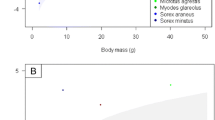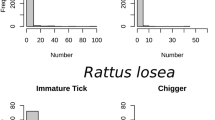Abstract
We investigated the Amblyomma fuscum load on a pullulating wild rodent population and the environmental and biological factors influencing the tick load on the hosts. One hundred and three individuals of Thrichomys laurentius were caught in an Atlantic forest fragment in northeastern Brazil, as part of a longitudinal survey on ticks infesting non-volant small mammals. Ticks (n = 342) were found on 45 individuals and the overall mean intensity of infestation was 7.6 ticks per infested rodent. Ticks were highly aggregated in the host population and the negative binomial distribution model provides a statistically satisfactory fit. The aggregated distribution was influenced by sex and age of the host. The microhabitat preference by T. laurentius probably increases contact opportunities between hosts and aggregated infesting stages of the ticks and represents important clues about the habitat suitability for A. fuscum.

Similar content being viewed by others
References
Andrade K, Rodal MJ (2004) Fisionomia e estrutura de um remanescente de floresta estacional semidecidual de terras baixas no nordeste do Brasil. Rev Bras Bot 27:463–474
August PV (1983) The role of habitat complexity and heterogeneity in structuring tropical mammal communities. Ecology 64:1495–1507
Barros-Battesti DM, Yoshinari NH, Bonoldi VL, de Castro Gomes A (2000) Parasitism by Ixodes didelphidis and I. loricatus (Acari: Ixodidae) on small wild mammals from an Atlantic Forest in the State of São Paulo, Brazil. J Med Entomol 37:820–827
Bittencourt EB, Rocha CF (2003) Host-ectoparasite specificity in a small mammal community in an area of Atlantic rain forest (Ilha Grande, State of Rio de Janeiro), southeastern Brazil. Mem Inst Oswaldo Cruz 98:793–798
Bossi DE, Linhares AX, Bergallo HG (2002) Parasitic arthropods of some wild rodents from Juréia-Itatins Ecological Station, state of São Paulo, Brazil. Mem Inst Oswaldo Cruz 97:959–963
Boyard C, Vourc’h G, Barnouin J (2008) The relationships between Ixodes ricinus and small mammal species at the woodland–pasture interface. Exp Appl Acarol 44:61–76
Brunner JL, Ostfeld RS (2008) Multiple causes of variable tick burdens on small-mammal hosts. Ecology 89:2259–2272
Daniels TJ, Fish D (1990) Spatial distribution and dispersal of unfed larval Ixodes dammini (Acari: Ixodidae) in southern New York. Environ Entomol 19:1029–1033
Dantas-Torres F, Oliveira-Filho EF, Soares FAM, Souza BOF, Valença RBP, Sa FB (2008) Ticks infesting amphibians and reptiles in Pernambuco, northeastern Brazil. Rev Bras Parasitol Vet 17:218–221
Dantas-Torres F, Aléssio FM, Siqueira DB, Mauffrey JF, Marvulo MFV, Martins TF, Moraes-Filho J, Camargo MCGO, Nicoletti D’Auria SG, Labruna MB, Silva JCR (2012) Exposure of small mammals to ticks and rickettsiae in Atlantic Forest patches in the metropolitan area of Recife, north-eastern Brazil. Parasitology 139:83–91
Freitas SR, Cerqueira R, Vieira MV (2002) A device and standard variables to describe microhabitat structure of small mammals based on plant cover. Braz J Biol 62:795–800
Guerra M, Walker E, Jones C, Paskewitz S, Cortinas MR, Stancil A, Beck L, Bobo M, Kitron U (2002) Predicting the risk of lyme disease: habitat suitability for Ixodes scapularis in the North Central United States. Emerg Infect Dis 8:289–297
Hammer O, Harper DAT, Ryan D (2001) PAST: paleontological statistics software package for education and data analysis. Palaentol Electron 4:9
Martins TF, Dantas-Torres F, Nieri-Bastos FA, Marcili A, Siqueira DB, Aléssio FM, Mauffrey JF, Marvulo MF, Silva JC, Labruna MB (2009) Host records for the immature stages of the South american tick, Amblyomma fuscum (Acari: Ixodidae). Entomol News 120:370–374
Nava S, Mangold AJ, Guglielmone AA (2006) The natural hosts for larvae and nymphs of Amblyomma neumanni and Amblyomma parvum (Acari: Ixodidae). Exp Appl Acarol 40:123–131
Nava S, Mangold AJ, Guglielmone AA (2009) Seasonal distribution of larvae and nymphs of Amblyomma tigrinum Koch, 1844 (Acari: Ixodidae). Vet Parasitol 166:340–342
Nava S, Mangold AJ, Mastropaolo M, Venzal JM, Fracassi N, Guglielmone AA (2011) Seasonal dynamics and hosts of Amblyomma triste (Acari: Ixodidae) in Argentina. Vet Parasitol 181:301–308
Ostfeld RS, Hasler KR, Cepeda OM (1996a) Temporal and spatial dynamics of Ixodes scapularis (Acari: Ixodidae) in a rural landscape. J Med Entomol 33:90–95
Ostfeld RS, Miller MC, Hazler KR (1996b) Causes and consequences of ticks (Ixodes scapularis) burdens on white-footed mice (Peromyscus leucopus). J Mammal 77:266–273
Pardini R, de Souza SM, Braga-Neto R, Metzger JP (2005) The role of forest structure, fragment size and corridors in maintaining small mammal abundance and diversity in an Atlantic Forest landscape. Biol Conserv 124:253–266
Paziewska A, Zwolinska L, Harris PD, Bajer A, Sinski E (2010) Utilization of rodent species by larvae and nymphs of hard ticks (Ixodidae) in two habitats in NE Poland. Exp Appl Acarol 50:79–91
Pontes JAL, Figueiredo JP, Pontes RC, Rocha CFD (2008) Snakes from the Atlantic rain forest area of Serra do Mendanha, in Rio de Janeiro state, southeastern Brazil: a first approximation to the taxocenosis composition. Braz J Biol 68:601–608
Poulin R (2007) Evolutionary ecology of parasites, 2nd edn. Princeton University Press, Princeton
Randolph SE (2004) Tick ecology: processes and patterns behind the epidemiological risk posed by ixodid ticks as vectors. Parasitology 129:S37–S65
Randolph SE, Storey K (1999) Impact of microclimate on immature tick-rodent host interactions (Acari: Ixodidae): implications for parasite transmission. J Med Entomol 36:741–748
Reis SF, Pessôa LM (2004) Thrichomys apereoides. Mammal Species 3(4):1–5
Schulze TL, Jordan RA (2005) Influence of meso- and microscale habitat structure on focal distribution of sympatric Ixodes scapularis and Amblyomma americanum (Acari: Ixodidae). J Med Entomol 42:285–294
Shaw DJ, Grenfell BT, Dobson AP (1998) Patterns of macroparasite aggregation in wildlife host populations. Parasitology 117:597–610
Sonenshine DE, Mather TN (1994) Ecological dynamics of tick-borne zoonoses. Oxford University Press, USA
Sonenshine DE, Stout J (1968) Tick burdens in relation to spacing and range of hosts in Dermacentor variabilis. J Med Entomol 5:49–52
Stanko M, Krasnov BR, Miklisova D, Morand S (2007) Simple epidemiological model predicts the relationships between prevalence and abundance in ixodid ticks. Parasitology 134:59–68
Streilen KE (1982) The ecology of small mammals in the semiarid Brazilian Caatinga. III. Reproductive biology and population ecology. Ann Carnegie Mus 51:251–269
R Development Core Team (2009) R: a language and environment for statistical computing, Vienna, Austria. Available at: http://www.R-project.org
Zuk M, McKean KA (1996) Sex differences in parasite infections: patterns and processes. Int J Parasitol 26:1009–1024
Acknowledgments
Conselho Nacional de Desenvolvimento Científico e Tecnológico, CNPq (grant 478.229/2007-0 to JCRS), Institut de Recherche pour le Développement (IRD), Alβan Program fellowship to FMA, Instituto Brasileiro para Medicina da Conservação—Tríade.
Author information
Authors and Affiliations
Corresponding author
Rights and permissions
About this article
Cite this article
Aléssio, F.M., Dantas-Torres, F., Siqueira, D.B. et al. Ecological implications on the aggregation of Amblyomma fuscum (Acari: Ixodidae) on Thrichomys laurentius (Rodentia: Echimyidae), in northeastern Brazil. Exp Appl Acarol 57, 83–90 (2012). https://doi.org/10.1007/s10493-012-9531-3
Received:
Accepted:
Published:
Issue Date:
DOI: https://doi.org/10.1007/s10493-012-9531-3




